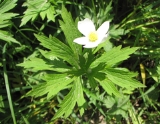
Anemone canadensis
Encyclopedia
Anemone canadensis is a herbaceous
perennial
native to moist meadow
s, thicket
s, stream
bank
s, and lake
shore
s in North America
, spreading rapidly by underground rhizome
s, valued for its white flower
s.
s with deeply divided and toothed basal leaves
grow from caudices
on long, thin rhizome
s.
Flowers with about 5 sepal
s and numerous stamen
s bloom from late spring to summer on stems above a cluster of leaves.
Seeds are achene
s, borne in a small dense head.
family.
Herbaceous plant
A herbaceous plant is a plant that has leaves and stems that die down at the end of the growing season to the soil level. They have no persistent woody stem above ground...
perennial
Perennial plant
A perennial plant or simply perennial is a plant that lives for more than two years. The term is often used to differentiate a plant from shorter lived annuals and biennials. The term is sometimes misused by commercial gardeners or horticulturalists to describe only herbaceous perennials...
native to moist meadow
Meadow
A meadow is a field vegetated primarily by grass and other non-woody plants . The term is from Old English mædwe. In agriculture a meadow is grassland which is not grazed by domestic livestock but rather allowed to grow unchecked in order to make hay...
s, thicket
Thicket
A thicket is a very dense stand of trees or tall shrubs, often dominated by only one or a few species, to the exclusion of all others. They may be formed by species that shed large amounts of highly viable seeds that are able to germinate in the shelter of the maternal plants.In some conditions the...
s, stream
Stream
A stream is a body of water with a current, confined within a bed and stream banks. Depending on its locale or certain characteristics, a stream may be referred to as a branch, brook, beck, burn, creek, "crick", gill , kill, lick, rill, river, syke, bayou, rivulet, streamage, wash, run or...
bank
Bank (geography)
A geographic bank has four definitions and applications:# Limnology: The shoreline of a pond, swamp, estuary, reservoir, or lake. The grade can vary from vertical to a shallow slope....
s, and lake
Lake
A lake is a body of relatively still fresh or salt water of considerable size, localized in a basin, that is surrounded by land. Lakes are inland and not part of the ocean and therefore are distinct from lagoons, and are larger and deeper than ponds. Lakes can be contrasted with rivers or streams,...
shore
Shore
A shore or shoreline is the fringe of land at the edge of a large body of water, such as an ocean, sea, or lake. In Physical Oceanography a shore is the wider fringe that is geologically modified by the action of the body of water past and present, while the beach is at the edge of the shore,...
s in North America
North America
North America is a continent wholly within the Northern Hemisphere and almost wholly within the Western Hemisphere. It is also considered a northern subcontinent of the Americas...
, spreading rapidly by underground rhizome
Rhizome
In botany and dendrology, a rhizome is a characteristically horizontal stem of a plant that is usually found underground, often sending out roots and shoots from its nodes...
s, valued for its white flower
Flower
A flower, sometimes known as a bloom or blossom, is the reproductive structure found in flowering plants . The biological function of a flower is to effect reproduction, usually by providing a mechanism for the union of sperm with eggs...
s.
Description
ShootShoot
Shoots are new plant growth, they can include stems, flowering stems with flower buds, and leaves. The new growth from seed germination that grows upward is a shoot where leaves will develop...
s with deeply divided and toothed basal leaves
Leaf
A leaf is an organ of a vascular plant, as defined in botanical terms, and in particular in plant morphology. Foliage is a mass noun that refers to leaves as a feature of plants....
grow from caudices
Caudex
A caudex is a form of stem morphology appearing as a thickened, short, perennial stem that is either underground or near ground level . It may be swollen for the purpose of water storage, especially in xerophytes...
on long, thin rhizome
Rhizome
In botany and dendrology, a rhizome is a characteristically horizontal stem of a plant that is usually found underground, often sending out roots and shoots from its nodes...
s.
Flowers with about 5 sepal
Sepal
A sepal is a part of the flower of angiosperms . Collectively the sepals form the calyx, which is the outermost whorl of parts that form a flower. Usually green, sepals have the typical function of protecting the petals when the flower is in bud...
s and numerous stamen
Stamen
The stamen is the pollen producing reproductive organ of a flower...
s bloom from late spring to summer on stems above a cluster of leaves.
Seeds are achene
Achene
An achene is a type of simple dry fruit produced by many species of flowering plants. Achenes are monocarpellate and indehiscent...
s, borne in a small dense head.
Uses
In former times it was used medically by North American Indigenous peoples as an astringent and as a styptic for wounds, sores, nosebleeds, and as an eyewash. The root was respected by Plains tribes and used for many ailments.Toxicity
It is likely that most Anemones contain the caustic irritants of the RanunculaceaeRanunculaceae
Ranunculaceae are a family of about 1700 species of flowering plants in about 60 genera, distributed worldwide....
family.

